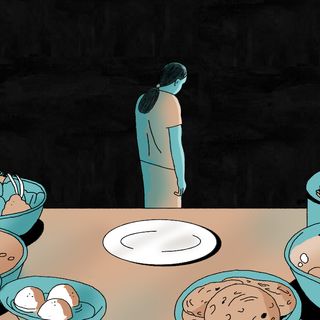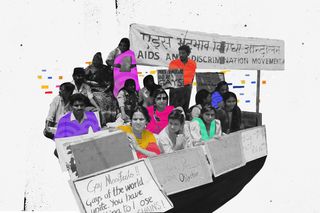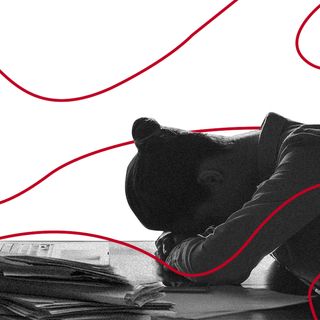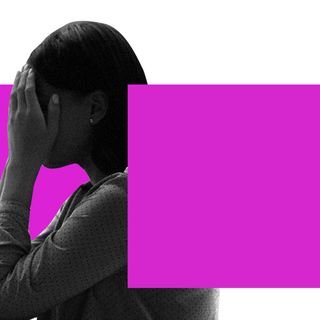
India’s Healthcare System Is Still Failing Queer‑Trans People. A Public Health Movement Can Change That.
The HIV/AIDS anti-discrimination movement in the ‘90s showed us that public health movements can advance people’s rights movements.

In 1994, doctors associated with the AIDS control program in Delhi were attending to inmates of the Tihar Jail and found a large number of inmates engaging in “homosexual acts.” The doctors demanded that condoms be distributed to inmates of the prison. Kiran Bedi, the then Inspector General (Prisons), Delhi, was flabbergasted and held the ground that distributing condoms to the inmates will only serve towards encouraging “immoral behavior.”
As we celebrate Pride Month in an increasingly capitalized and corporatized fashion, it’s important to note that not much has changed in terms of queer and trans people’s access to public health. The public-health infrastructure in India is crumbling in the current Covid19 pandemic, highlighting the glaring inequalities in who can access whatever remains of these institutions.
Public-health movements can support and sometimes even contribute significantly to people’s-rights movements. In fact, a lot of people’s-rights movements are about equitable and fair access to public healthcare. In the case of India’s queer and trans movement, the HIV/AIDS movement was a crucial marker for various social and civil rights.
However, any attempt to speak about this historical relationship between the two movements is incomplete without a critique. One must also ask questions like, where does the emancipatory potential of India’s public-health system currently stand? Especially since India is indeed in the severe clutches of another pandemic, this is a prime moment to evaluate India’s public-health system and strategies in the context of marginalized people and their rights.
HIV/AIDS and the public articulation of queer and trans identities
When the first phase of the National AIDS Control Program (NACP) was officiated in 1992, “men having sex with men,” or more commonly “MSM,” was identified as a high-risk group. In the later phases of the NACP, the term “MSM” was disaggregated into “MSM” and “transgender (TG).” In talking about the HIV/AIDS epidemic, the country was finally acknowledging the presence of queer people, which allowed queer and trans peopls’s demand for equal civil and social rights to be amplified. Homosexuality was no longer a Western import, and neither were the rights of queer, trans people.
The government realized soon that, due to the social stigma and legal discrimination, queer, trans people at the grassroots were inaccessible and unreachable to the system. The government, therefore, had to put their trust (and money) in non-governmental organizations (NGOs) and community-based organizations (CBOs) that had local networks to raise awareness and build solidarity. Outreach work needs outreach workers. These community-led organizations thus hired queer and trans people, primarily from the “MSM” and “TG” communities — leading to employment for these communities.
It was also soon realized that the socio-legal discrimination faced by queer-trans people translates into severe discrimination in accessing healthcare. Consequently, many of these NGOs and CBOs that were born initially with the goal of targeting the HIV/AIDS epidemic started taking up the causes of civil, social, and legal rights for queer and trans people. This is a prime example of how a public-health movement can and does feed into movements concerning the lives and rights of people.
Related on The Swaddle:
Problems with the HIV/AIDS intervention approach
There are, however, glaring inequalities and oppressions within the HIV/AIDS anti-discrimination, prevention, and intervention movement. I spoke to three queer/trans individuals to understand these lacunae better — Avinaba Dutta, a queer/trans-rights activist and a public-policy researcher; Aniruddha Dutta, Ph.D., an associate professor at the University of Iowa with extensive experience working with queer/trans people in Eastern India; and Chayanika Shah, Ph.D., a queer-rights activist. My conversations with the three highlighted the following problems with the HIV/AIDS-dominated narrative of India’s queer/trans-rights movements.
The first and foremost issue is one that can be extended to almost all public-health approaches concerning the lives of queer-trans people — a biologically essentialist framing of queer and trans identities. In the HIV/AIDS intervention programs, for example, MSM as a category subsumed various transfeminine identities. While there was a disaggregation of MSM and transgender people later, this was not based on self-identification and did not take into account subtle nuances of various cultural trans identities whose direct Anglophonic translation is not possible (for example, people who identify as kothi, hijra, dhupli).
Further, the narrative that was popularized by the HIV/AIDS intervention programs was more concerned with the stereotyped sexual behavior of queer/trans individuals than any real engagement with identity and politics. Because HIV/AIDS was not considered a possibility in the context of “traditional” monogamous marriages, married women who were at a high risk of contracting HIV from their promiscuous husbands were not included in “high-risk” categories for a long time and nor were the “inserting partners” (panthis; sic) in an “MSM” relationship. This led to two things: one, the state-constructed image of women and femininity became highly desexualized and monogamous, and people from various transfeminine communities became synonymous with individuals carrying HIV/AIDS. Secondly, many people who were at a high-risk of contracting HIV were not paid attention to due to a lack of engagement from both the state and the HIV/AIDS intervention movement itself.
The approach to the rights of queer-trans people through a singular focus on HIV/AIDS intervention and prevention also severely impacted future work concerning the emancipation and empowerment of queer-trans people. It limited the kind of claims that queer-trans individuals can make from the public-health system — anti-retroviral therapy (ART) and, more recently, hormone replacement therapy (HRT) and sex-reassignment surgeries (SRS). Beyond this, there has been very little conversation regarding the health of people living with a compromised immune system, queer/trans-friendly mental healthcare, queer/trans-friendly staff and caretakers. Also, the HIV/AIDS intervention approach led to a lasting wrongful portrayal of queer/trans individuals as those solely responsible for the epidemic. Queer/trans people, who are already discriminated against, are still socially seen as disease-carrying individuals to be avoided and isolated at all costs.
Then there are concerns with the NGOisation of the queer and trans movements. Barring charges of corruption against some NGOs and collectives (e.g., MANAS Bangla), there is the problem of elite, metropolitan NGOs dominating discussions concerning HIV/AIDS intervention and the rights of queer and trans people. This has also added pressure on smaller, community-led organizations from suburban and rural areas to become intelligible to elite activists and the state, leading to an anglicization and sanitization of the movement. Also, elite NGOs in metropolitan areas are led primarily by dominant-caste individuals, who refuse to engage with the anti-caste movements and struggles of DBA queer/trans individuals.
Moreover, a lot of these NGOs have followed exploitative practices. For example, outreach workers (often working-class queer/trans people who are actually on the ground) were paid below-minimum wages under the garb that their work is of “voluntary” nature. The managerial positions, on the other hand, were held by elite people, who were sometimes not even queer/trans-identifying, therefore reflecting and reinforcing social hierarchies within these organizations.
The HIV/AIDS intervention approach itself can be criticized for being more of a number-driven approach rather than political mobilization and emancipation of queer-trans communities. Vulnerable queer-trans people were often coerced into testing for HIV/AIDS, while being reduced to numbers throughout the whole process. A report by Aneka Collective and the Karnataka Sexual Minorities Forum (KSMF) highlights some of these problems:
“There is a profound lack of respect and understanding of communities. For instance, non-acceptance of testing or treatment is understood as a lack of knowledge of the disease, cultural resistance and not realizing the need to seek care… Cognizance of issues around what is termed as ‘sexual behavior’ is not seen in any context within which those behaviors take place — i.e., the life circumstances — but are viewed as merely behaviour of particular individuals (sometimes viewed as irresponsible or ignorant). The need to inform and spread awareness is a valid proposition. But, to revolve a campaign around the fact that people do not know and have to be educated is not just limiting and narrow but also arrogant.”
The lack of political mobilization and empowerment of queer-trans people during the intervention movement also had an aftermath in the lives of working-class queer/trans people. The singular focus on getting better numbers out of the intervention approach did not prepare working-class queer/trans people associated with these NGOs for the future, and as the transnational funding for HIV/AIDS intervention work reduced slowly as well as the current fascist government clamped down on NGOs, many outreach workers have lost their jobs and have had to go back to precarious forms of sex work or begging for sustenance.
Where we stand now
In 2017, the Ministry of Information and Broadcasting banned condom ads on television from 6 a.m. to 10 p.m., citing “indecency” and the potential to influence children into “unhealthy practices.” Moreover, around 20,000 NGOs in the country have had their registrations canceled and many left unable to accept transnational funding due to arbitrary rules against NGOs doing “political activities” in the 2010 amendments of the Foreign Contribution Regulatory Act. These measures are a great blow to India’s HIV/AIDS intervention program, as well as the engagement of NGOs with political, social, and civil rights movements. While there has been a lot of clamor around marriage equality, the public health infrastructure is crumbling and still does not cater to the needs of queer-trans people.
As the lack of healthcare and vaccines during the current Covid19 pandemic has shown us, the government seems to be neither concerned with building an equitable and accessible public health system, nor interested in the healthcare needs of queer-trans people.
Moreover, there has been an increasing impetus towards the privatization of India’s public health system. This privatization puts an unfair burden on those who cannot afford private healthcare. Also, there has been very little awareness building in the public health care system, which still discriminates against queer-trans people and people from other marginalized groups. Affordable and accessible healthcare in India remains a distant dream, even as the Indian government does not spare any opportunity to pat its own back.
Thus, the future of how the rights of queer-trans people intersects with demands for equitable and accessible public healthcare is hard to predict.
As Dr. Aqsa Shaikh, a transgender woman and an associate professor of community medicine in the Hamdard Institute of Medical Sciences, pointed out during our conversations that there can never be any improvement in public health without engaging with various social inequities and inequalities; a public-health approach that does not work with a community-focused improvement in the healthcare system is bound to fail. As the Covid19 vaccine crisis has revealed, decision-making about public health has become more and more centralized, with voices from the ground rarely being heard.
Dr. Shaikh believes that miracles can happen when the affected communities are integrated into the decision-making process regarding public-health. Is the government listening? Possibly not. This Pride Month, it is essential that we draw national and international attention towards building a robust public-health system that does not discriminate against people and is affordable and accessible to all.
Sayantan Datta is a queer-trans science writer, communicator, and journalist. You can find them on @queersprings on Twitter and @prabhasvaramitra on Instagram.
Related


‘Toxic’ Workplace Culture Linked To a Threefold Increase in Risk of Depression, Study Shows
